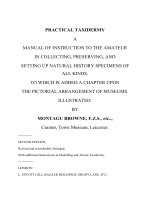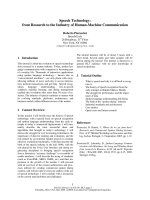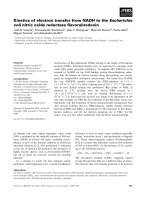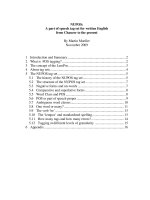university of california press from marriage to the market the transformation of womens lives and work aug 2006
Bạn đang xem bản rút gọn của tài liệu. Xem và tải ngay bản đầy đủ của tài liệu tại đây (1.32 MB, 311 trang )
FROM MARRIAGE TO THE MARKET
University of California Press Berkeley Los Angeles London
FROM MARRIAGE
TO THE MARKET
The Transformation of
Women’s Lives and Work
Susan Thistle
University of California Press
Berkeley and Los Angeles, California
University of California Press, Ltd.
London, England
© 2006 by The Regents of the University of California
Library of Congress Cataloging-in-Publication Data
Thistle, Susan.
From marriage to the market : the transformation of women’s
lives and work / Susan Thistle.
p. cm.
Includes bibliographical references and index.
ISBN-13: 978-0-520-24590-7 (cloth : alk. paper),
ISBN-10: 0–520-24590-3 (cloth : alk. paper)
ISBN-13: 978-0-520-24646-1 (pbk. : alk. paper),
ISBN-10: 0–520-24646-2 (pbk. : alk. paper)
1. Women—Employment—United States—History—20th
century. 2. Women—United States—Economic conditions.
3. Women—United States—Social conditions. 4. Work and
family—United States. I. Title.
HD6095.T49 2006
331.40973'09045—dc22 2005031019
Manufactured in the United States of America
14 13 12 11 10 09 08 07 06
1110987654321
This book is printed on New Leaf EcoBook 60, containing 60%
postconsumer waste, processed chlorine free; 30% de-inked
recycled fiber, elemental chlorine free; and 10% FSC-certified
virgin fiber, totally chlorine free. EcoBook 60 is acid free and
meets the minimum requirements of ANSI/ASTM D5634–01
(Permanence of Paper).
⅜
∞
To my mother,
Mary Burnham MacCracken,
with thanks
List of Tables xi
Acknowledgments xiii
1. A World Turned Inside Out 1
2. Support for Women’s Domestic Economy
in the Nineteenth and Early Twentieth
Centuries
15
3. The Breakdown of Women’s Domestic
Economy after World War II
35
4. Economic Difficulties and a Contradictory
Alliance
54
5. The Formation of a Female Underclass 79
6. The “New Economy” and the Transformation
of Women’s Work
99
7. How and Why Mothers Have Been
Shortchanged
133
8. New Possibilities and Old Inequalities 167
Notes 185
Bibliography 251
Index 287
CONTENTS
educated women, by race, 1960–90 74
2. Labor force participation, motherhood, and marriage among high
school–educated women, by race, 1960–90 76
3. Poor single mothers compared to other women, by race, 1960 81
4. Effect of marriage and work on probability of poverty for a typical
mother, by race, 1960 83
5. Single mothers in poverty, by age and race, 1960–90 86
6. Single mothers in poverty, by education and race, 1960–90 90
7. Effect of marriage and work on probability of poverty for a typical
mother, by race, 1990 95
8. Poor single mothers compared to other women, by race, 1990 96
9. Ratios comparing poor single mothers to other women, by race, 1960
and 1990 97
10. Employment growth in the private sector, by industry, 1970–2000 103
11. Women’s work as share of private-sector GDP, 1970 107
12. Women’s work as share of private-sector GDP, 2000 108
ix
FIGURES
13. Married women’s sources of support, by race, 1960 and 2000 116
14. Married women’s reliance on men’s income, by race, 1960 117
15. Married women’s reliance on men’s income, by race, 2000 118
16. All women’s sources of support, by race, 1960 and 2000 119
17. All women’s reliance on men’s income, by race, 1960 120
18. All women’s reliance on men’s income, by race, 2000 121
19. Trends in labor force participation, by race, 1960–2000 125
20. Trends in marriage, by race, 1960–2000 126
21. Trends in poverty among unmarried mothers, by education and race,
1960–2000 128
22. Trends in poverty among unmarried mothers, by age and race,
1960–2000 130
23. Sources of mothers’ support, by race, 1960 and 2000 137
24. Change in total family income among married mothers, by education
and race, 1970–2000 149
25. Change in total family income among unmarried mothers, by education
and race, 1970–2000 153
26. Mothers employed 35ϩ hours per week, by education and race,
2000 156
27. Detailed sources of mothers’ support, by race, 2000 158
x Figures
1. Income and work of married white mothers, 1970 and 2000 147
2. Income and work of married black mothers, 1970 and 2000 148
3. Income and work of unmarried white mothers, 1970 and 2000 151
4. Income and work of unmarried black mothers, 1970 and 2000 152
5. Mean labor force attachment of mothers, by education and race, 2000 155
xi
TABLES
going until the end. Much support from others sustained me during this en-
deavor, cheering me on. I am fortunate to have friends with both keen analytic
minds and kind hearts. Their ability to think in large theoretical terms was in-
valuable, as was their ongoing enthusiasm for this project. In particular I would
like to thank Lyn Spillman, whose superb intellectual strengths, repeated asser-
tion of the value of larger conceptual projects, and gracious encouragement
were invaluable. I also thank Hilarie Lieb, for long walks and talks in which to
think through the details of this project. Always supportive as a friend and col-
league, she generously offered her perspective and skills as an economist and
was crucial to this project’s success. I thank as well Orville Lee, for his ability to
develop the logic of an argument and for his appreciation of grand theory and
both the strengths and vulnerabilities of his friends; and Russ Faeges and Marc
Steinberg for again affirming the value of theory and for supportive comments.
The Department of Sociology at Northwestern University is a place of great
minds and collegial spirit that is keeping alive the grander traditions in sociol-
ogy, a sociology still committed to big ideas. I am grateful to everyone in the
department for providing a supportive institutional and intellectual environ-
ment in which I could write this book. Special thanks go to Carol Heimer, for
ensuring that I had a room of my own and £500 or so, and for warmly believ-
ing in the value of this work. A similar thanks to Wendy Espeland, who kept en-
couraging me as I labored through the difficult last stretch. I also thank in par-
xiii
ACKNOWLEDGMENTS
ticular Paula England, for her constant willingness to talk about sex, pregnancy,
and shotgun weddings and for her generous spirit; Mary Patillo and Ann
Orloff; and, in the Department of Psychology, Alice Eagly, for kindly reading
chapters. You have all done your best; any failures are my own.
I also thank Mike Hout, who got me excited about statistics; Erik Wright, for
providing a space in which my thoughts could develop; Vicki Bonnell, Mary
Ryan, and Kristin Luker, for encouraging me to take on this large endeavor; and
Ann Swidler and Jane Mansbridge, for later support when needed. Thanks as
well to my first professors at the Jackson School of International Studies at the
University of Washington—Bruce Cumings, Dan Chirot, Joel Migdal, and Liz
Perry—who may be surprised to see the use to which I put their teachings.
A grant from the American Association of University Women provided sup-
port in more than financial terms, as it also validated research on women’s lives.
I am grateful to the National Science Foundation for a grant funding my initial
analyses of women’s poverty. I also thank the Helen Whiteley Center at the Uni-
versity of Washington, and the Friday Harbor Marine Lab of which it is a part,
for providing a lovely place in which to write parts of this book.
This book could not have been written without an enormous amount of ear-
lier work done by a wide range of scholars, as the lengthy endnotes make clear.
Key to its research were the Integrated Public Use Microdata Series from the U.S.
census, admirably standardized by Steve Ruggles, Matthew Sobek, Trent Alexan-
der, Catherine A. Fitch, Ronald Goeken, Patricia Kelly Hall, Miriam King, and
Chad Ronnander at the Population Center at the University of Minnesota. I am
grateful to Ann Janda for directing me toward these and other archival data.
I would also like to thank my family in all its extended forms. Each of you
helped in your own way. Much appreciation also goes to all my friends of many
years, some of whom I have lost touch with while this book consumed my at-
tention. You know who you are, and I still appreciate you. This is especially true
of Ellie Dorsey, who lived her short life to the fullest and whose cheerful kind-
ness, keen intelligence, and love for both her family and her work remain an
inspiration.
During one stretch in writing this book I ran with the Concord Runners, a
group that has been together more than twenty-five years. Early Saturday morn-
ings we would run six miles and then all eat breakfast in the basement of a town
building. As we passed the halfway point of our run and turned for home, the
others would take off, leaving me further and further behind. Exhausted, want-
ing to walk but having miles to go, I would plod on, chanting “Just keep going,
just keep going,” envisioning the good friends and food waiting up ahead. For
all of those in academia struggling to move forward in difficult times, I en-
courage you also to keep going. Better times may lie ahead.
xiv Acknowledgments
American homes changed dramatically over the second half of the twentieth
century. Wives and mothers entered the labor force in great numbers; the laws
and customs that once framed marriage and parenthood came apart; and gov-
ernment aid to single mothers all but disappeared. Pregnancy, child care, and
even the most intimate sexual acts became topics of public debate.
The end result, as we begin a new century, is that the lives of women and
those closest to them have been turned inside out. Many mothers and children
as well as men now spend most of their waking hours outside their own homes,
and wages, not marriage, provide women’s main source of support. Breast
pumps are carried in briefcases; conception may take place in clinics. Family life
is carefully fitted in at the edges of the day or week. These changes have been
major and traumatic ones. We are still struggling to adjust to them, without fully
grasping what has happened to our lives or the consequences of these events for
our children.
The shape of the American economy has changed as well. Office buildings
and shopping malls have replaced factories and farms; faxes and e-mails have
taken the place of letters. There is much talk of the “new economy” that has
emerged, symbolized by computers, cell phones, and the Internet. Yet techno-
logical advances, unimaginable in earlier times, have been joined with unan-
ticipated hardships, at work as well as at home. Despite all the new inventions,
time seems to have grown increasingly scarce, and jobs more intense and de-
manding, yet less secure, than in the past.
1
A WORLD TURNED INSIDE OUT
1
2 A World Turned Inside Out
Women born in the first decades after World War II have traced out their lives
across this stretch of years. Looking back, it is clear they undertook a great jour-
ney, one leading them not just out into the terrain of paid work but also far from
the old domestic realm of their mothers, in its different shapes and forms. A
world has been lost as well as gained. Each wave of women coming after them
has sought a better balance of home and work. Yet members of each group,
from those in their 50s to those just entering adulthood, are still struggling to
fit the pieces of their lives together. Whether lawyers or secretaries, married or
single, women talk of being overburdened by the demands of work at home and
for pay. Many do sink, despite their efforts, into poverty.
As women struggle to carry out their labors of love in the face of waning pri-
vate and public assistance for such tasks, we have to ask ourselves how we came
to such a place. What happened to the older world where most women focused
on care of their families and homes, and were supported in these tasks? Why is
it so hard for women to realize the new American dream of both meaningful
work and satisfying personal lives?
The Hidden Half of Women’s Story
Many excellent studies have examined one or another of the cultural, social, and
political upheavals in women’s lives in the decades after World War II, from the
battles over abortion or the Equal Rights Amendment in the 1970s and 1980s
to the difficulties facing working mothers at the start of the twenty-first cen-
tury.
1
However, most social scientists have analyzed these issues separately. Yet
these are not isolated problems but intertwined pieces of a larger process of his-
toric change that has not yet been fully grasped.
In this book, I provide a new understanding of the underlying causes of the
events dramatically transforming women’s lives, and the very nature of gender
itself, in the last decades of the twentieth century. I explain both how and why
women’s relationships to marriage, motherhood, and the labor force have al-
tered profoundly over these years and the consequences of these shifts for the
new economy of today.
Rather than focusing as many others have on the loss of the male breadwin-
ner wage, I argue that behind the traumatic events of recent decades lies a fun-
damental transformation of women’s own work, resulting from a decisive en-
counter between the domestic realm and a maturing market. A lessening of
household chores by an expanding post–World War II economy also offering
new opportunities led several different groups to challenge and dismantle the
old rules not only holding women in the home but also committing men, em-
ployers, and the state to some support for such labor. The transformation of
A World Turned Inside Out 3
women’s household tasks and labor into work done for pay then played a key
role in the rise of a new cycle of economic growth and prosperity in the United
States, creating great gains in free time and income. Yet women and their fam-
ilies have realized few of these gains, and they have done so unequally.
I develop this argument through a detailed examination of the experiences
of African American women and white women, especially between 1960 and
2000. Careful comparison of these two sharply contrasting situations is one of
the most effective ways to unearth the deeper causes of the past and present dif-
ficulties in women’s lives. I also set these women’s experiences in the context of
a larger process of social change. By stepping back to this larger view, we are able
to see connections between events not evident with too close a focus.
Such an analysis reveals a hidden side to the story of women’s lives that has
not yet been told. We cannot fully understand the dramatic alterations in gen-
der relations, or in the worlds of home and work, without it. Only when we lift
the domestic realm clearly into view can we see what once held this realm to-
gether, even in the face of great poverty, and why it has now come apart. Many
of the problems that confronted women over the second half of the twentieth
century, from the rise of single mothers among the poor to the recent time
crunch faced by many families, are tied to the failure to consider this half of
their story. This oversight has also limited efforts to explain why such difficul-
ties arose.
In tracing what has been hidden in the women’s story, I challenge several ac-
cepted beliefs, including some held by feminists. This account shows that
women’s movement into the labor force will not in itself bring equality. It also
sees many of the recent problems confronting women as stemming not from
the persistence of men’s control but rather from the collapse of the arrangement
on which men’s power was based, as interest in supporting women’s domestic
labor lessened. Finally, it makes clear that a focus on the market alone, or any
one group of women or men, cannot explain recent alterations in gender rela-
tions and family structures. However, while looking closely at differences by
race and class, this book also uncovers important similarities in the events trans-
forming women’s lives, suggesting a path as well toward a common resolution
of the problems they now face.
The Changing Shape of Families
While scholars have analyzed women’s entrance into the labor force in detail,
changes in family structure have been harder to explain. For many decades now,
arguments have raged over whether such changes are caused by failures in in-
dividual behaviors or in the structure of the economy itself. Some emphasize
4 A World Turned Inside Out
the disappearance of an old set of family values that once stabilized home life.
They point to a loss of discipline, particularly among the poor, or to the rise of
individualism, especially in women intent on their careers.
2
Others argue that shifts in the market economy underlie the new patterns in
marriage and parenthood that have emerged. Women’s increased employment
is often seen as fueling the rise in divorce or challenges to the old domestic role.
Some have stressed instead the changing circumstances of men’s work, arguing
that the disappearance of well-paid manufacturing jobs lies behind lower rates
of marriage. Analysts also often point to men’s declining wages to explain the
end of the family centered on the male breadwinner and married women’s
movement into the labor force. However, women’s turn to paid work began well
before men’s employment difficulties, and marriage rates, though falling more
among the poor and unemployed, have declined across the economic spec-
trum.
3
All these approaches, whether emphasizing changes in people’s beliefs or in
the labor force itself, are marred by a similar flaw, a failure to fully grasp the re-
lationship between developments in both private and public realms. The links
between changing economic, cultural, and legal conditions and new forms of
family life are still poorly understood. To perceive these connections, we need
to consider more than how behaviors or the wage economy have changed. We
also need a clear sense of how women’s work in the home—not only the tasks
themselves but also the framework of support for such labor—has altered. This
requires a look not just at the domestic realm but also at its relationship to the
market, and how this relationship has been transformed over time.
Women and the “New Economy”
There has been much talk recently of the “new economy” that has emerged
from the difficulties of the 1970s and 1980s. A reorganization of production,
joined with new technology, appears to have resulted in strong gains. Returns
to capital have increased by more than 40 percent since the early 1970s, and na-
tional income per person has risen more than one-third over its level thirty years
ago.
4
Though it has faltered somewhat in the first years of the twenty-first cen-
tury, an economy based on a distinctly different foundation than in the past ap-
pears to be firmly in place.
A commonly noted feature of this economy is the unequal distribution of its
rewards. Employers’ strategies to cut costs have resulted in a loss of job security
and many benefits, the closing of paths for advancement, and the proliferation
of low-wage dead-end jobs. Several analysts have spelled out clearly how these
problems stem from the breakdown of the old compact that shaped relations be-
tween employers and workers in the first decades after World War II. They make
A World Turned Inside Out 5
an effective argument for the need to create new rules to improve the conditions
of employment today.
5
However, the prosperity of the first post–World War II decades was also based
in part on women’s household labor and on a set of rules that supported such
work. The old rules shaping the domestic realm, as well as those of the work-
place, have collapsed. The conditions of women’s work in the home have also
grown increasingly insecure. Marriages are easily dissolved, and the arrange-
ments that once committed employers and the state as well as fathers to some
support for family maintenance have vanished.
It is widely acknowledged that women’s entry into the labor force in large
numbers was one of the central ways the economy changed over the latter half
of the twentieth century. Changes within the home during this period were
equally dramatic. However, analyses of these two areas have not yet been effec-
tively joined, despite growing recognition of the need for such a synthesis.
6
One area of analysis forging links between these two areas is that of care work.
This book adds an important dimension to such discussion by grounding moral
debates in the actual, changing conditions of women’s lives, revealing how and
why tasks of caregiving and support for such tasks altered in the late twentieth
century and who has benefited from such changes. The movement of much of
women’s work outside the home, for example, has played a major role in recent
economic growth. But because this contribution is largely unrecognized, the
market has taken too much and given too little back, in terms of time and sup-
port, to women and their families.
7
Righting this situation, however, requires another type of synthesis as well.
Issues of economic inequality have long dominated discussions of social justice.
More recently, though, many scholars and political activists have argued that
viewing some groups only in negative terms or not at all is a graver injustice,
blocking their claims for basic human rights. A full understanding of the prob-
lems facing women today requires that we think about both areas. As the
philosopher Nancy Fraser argues, we must consider “the ways in which eco-
nomic disadvantage and cultural disrespect are . . . entwined with and support
each other.”
8
To claim more of the gains that women have played a key role in
creating for home and family and to ensure their more equal distribution, we
must recognize the rights of all women to such resources. We also must make
visible an area of life long denied recognition, revealing the contributions made
both by the domestic realm and by its transformation.
Gender and Theories of Social Change
In considering the interaction between women’s lives and a still-unfolding pro-
cess of economic and political development, this study sets issues of gender in
6 A World Turned Inside Out
the context of the grand questions that first gave rise to sociological theory. The
central focus of these early theorists was the impact of an emerging market
economy on the established social order. Women, however, were absent from
such discussion, as their lives were thought to be determined by nature rather
than society.
9
A key contribution of feminist theory was the uncovering of the social forces
holding women in the home, thereby exposing men’s control of women’s work
and sexuality. Pioneering feminist scholars strove not only to explain the un-
derlying causes of women’s inequality but also to assess the effect of a devel-
oping market economy on women’s status.
10
Their attempts to conceptualize the
interactions between gender and ongoing commercial and industrial growth
soon ran into difficulties, however. In part, they were hampered by trying to fit
women’s experiences into a template based on men’s lives.
A large body of scholarship has analyzed the interactions between an ex-
panding market and older ways of work. The early classics of historical com-
parative sociology focused on men’s varying paths from fields to factories and
the impact of those paths on state formations.
11
However, these old classics were
framed too narrowly. Only when we broaden their explanations beyond an
agenda and set of categories based on one group of men, and the heavy-handed
role often given to capitalism in some accounts, can we gain a clear under-
standing of the profound changes now taking place among women themselves.
Thus, in dialogue with these older accounts of social change, this book devel-
ops a new explanation of women’s own varying routes from an older form of
work into the wage labor force, based on the experiences of African American
and white women, especially in recent decades.
In doing so, this analysis also builds on earlier examinations of the relation-
ship between women’s work and a developing market economy. In the first
decades after World War II a pathbreaking generation of scholars took on daunt-
ingly large projects, exploring changes in women’s lives and work in the United
States and in other countries over three centuries or more. The large historical
studies of Alice Kessler-Harris and Jacqueline Jones, for example, tracing the
shifting nature of the work done by women within as well as outside the home
since colonial times, have laid the groundwork for understanding the changing
relationship between these two realms. Jeanne Boydston and others, detailing
the organization of women’s domestic labor under men’s control and the con-
tinued importance of such work during the first stages of market development,
have expanded those foundations.
12
The central focus of these inquiries, how-
ever, was the period before World War II. A few scholars, such as Heidi Hart-
mann and Kessler-Harris, have perceptively analyzed the dramatic alterations in
gender relations that began to unfold after the war.
13
However, the explosive
A World Turned Inside Out 7
events of subsequent decades have not been fully explored. Yet the immense
changes in women’s lives and the American economy that took place in the sec-
ond half of the twentieth century and are continuing to unfold at a rapid pace
clearly merit careful analysis.
In part, further efforts at broad explanations were fractured by a growing
recognition that women’s experiences differ significantly by race, ethnicity, and
class. Greater attention to the past and present situations of women of color has
increased our understanding of the varied ways in which home and market may
be connected. For example, by showing how African American and other fam-
ilies have been shaped by the pressures of economic survival and discrimina-
tion, scholars such as Evelyn Nakano Glenn and Bonnie Thornton Dill have es-
tablished the importance of looking at the domestic realm, and its relationship
to the larger economy, rather than at the labor force alone. They have also
stressed the changing nature of this relationship and how it has varied by race
and ethnicity. As Glenn has put it, “reproductive labor has divided along racial
as well as gender lines, and the specific characteristics have changed over
time as capitalism has been reorganized.”
14
Their studies remain highly relevant,
revealing, for example, the ways that the market can devour time needed for
family life.
A growing number of analysts are also assessing how different groups of
women of color are faring in the wage economy, documenting the persistence
of inequality despite some gains in education, occupational status, and earnings.
However, as several scholars have noted, the end result has been a rather frag-
mented approach to issues of racial and ethnic difference. What is needed now,
they stress, is a clearer grasp of the larger processes lying behind the variations
in women’s experience.
15
To create such an analytic framework, we need first to take on again the
larger questions once asked of women’s lives, reframed to consider differences
by race and class. Second, rather than assuming the persistence of old in-
equalities, we need to think about ways in which the abandonment of estab-
lished systems of control may have contributed to today’s problems. While
emphasis on women’s role as mothers, for example, once blocked their op-
portunities outside the home, the withdrawal of support for women’s domes-
tic labor in recent years is creating new hardships. Further, the breakdown of
such support—however minimal it was—has had far more negative conse-
quences for black women than for white non-Hispanic women. Thus, this
study seeks to explain the great changes taking place in women’s lives and
American homes, and how they are shaping the new economic and social order
of today. In doing so, it reveals the outcome of a long interaction between gen-
der, race, and the market.
8 A World Turned Inside Out
A Comparative Analysis
In the largest sense, what is needed is comparative analysis of the ways in which
gender has interacted with varying processes of industrialization among all
racial and ethnic groups of women, both within and outside the United States.
Such analysis would consider women’s different paths from household to wage
labor, the alliances influencing such transitions, the new state formations they
are resulting in, and how such transitions are shaped by and help shape the
global political economy. Here I contribute to this project by focusing on the
experiences of white women and African American women in the United
States, especially during the last decades of the twentieth century.
16
My intention thus is to provide not a detailed, continuous history spanning
all racial and ethnic groups but a new analytic framework that can make sense
of the recent traumatic changes in women’s lives. In order to effectively explain
current differences between women, we must first clearly understand the larger
forces underlying such variations. A close comparison of two different groups
enables us to see some important similarities in their experiences and their
deeper causes.
17
In brief, this book uncovers the larger dynamics shaping the lives of women
today by comparing how African American and white women interacted with
a developing market economy at selected key moments. These two groups were,
respectively, the largest racial minority and majority in the United States over
the past two centuries. Also, recent advances in data analysis provide access to
detailed information about both groups over the past 150 years, allowing con-
sideration of how two different relationships between home and market have
unfolded over time.
While issues of class have blurred the lines of this distinction by race, creat-
ing variations within each group, the experience of African American women
has been markedly different from that of white women. Thus race provides the
central comparative dimension, though this study also examines how recent
changes in the domestic realm have played out differently by education, or class,
within each group of women. A close look at the experiences of African Amer-
ican and white women makes possible a clearer understanding of how and why
women’s relationships to the home have altered profoundly in recent years, and
the connections between such alterations and the changing shape of the mar-
ket economy. Such comparison provides a rough theoretical map that can then
be used to explore other women’s experiences.
18
This is an interdisciplinary study, drawing together research from history,
economics, political science, sociology, and government documents, and orig-
inal analysis of census data, primarily from the Integrated Public Use Microdata
A World Turned Inside Out 9
Series. These recently standardized samples of decennial census data enable us
to carefully assess women’s relationships to home and work in the first decades
of the twentieth century as well as today. The large number of cases that they
provide also enables us to consider differences among African American women
by education, marital status, and cohort, for example, rather than relying on
general comparisons with white women, as in the past. By looking closely at
such data, we can see previously indiscernible variations in women’s changing
relationships to marriage, motherhood, and the labor force among African
American and white women at different educational levels over several decades.
Such analysis gives empirical detail to the larger story, enabling us to compare
the experiences of, for example, college-educated women and high school
dropouts over time, revealing similarities as well as differences in their experi-
ences by race.
19
As we follow the rapid changes in women’s lives over the second half of the
twentieth century, a sense of how such shifts have affected successive genera-
tions or, more precisely, cohorts of women is useful. This study looks at groups
familiar to the American public: the parents of the baby boomers, who raised
their families in the 1950s, and the baby boomers themselves, that large cohort
born between the late 1940s and the early 1960s, who rebelled against the tra-
ditional domestic role and entered the labor force in large numbers. The smaller
“bust” cohort, perhaps better known as Generation X, and the children of the
baby boomers themselves, carry this account into the present. This study traces
the breakdown of marriages, struggles with poverty, and acquisition of elite
professions or poorly paid service jobs over successive cohorts of African
American and white women as paid employment replaced marriage as their
central means of support.
Gender, Race, and the Market
To knit the details of women’s lives into a coherent analytic framework requires,
finally, a new way of thinking about gender itself and its interactions with a de-
veloping market economy. That the social construction of differences between
women and men shapes a wide range of human experience is now widely rec-
ognized. But the nature of what many have come to call this “structure” of gen-
der is still poorly formulated and lacks a dynamic of change.
20
Though women’s
lives have altered dramatically, our understanding of gender has not kept pace.
Feminist theorists themselves recognize that theoretical developments in dis-
cussions of gender have stalled. The grand analyses that began to appear in the
1970s, as Fraser observes, “soon reached an impasse: having begun by suppos-
10 A World Turned Inside Out
ing the fundamental distinctness of capitalism and patriarchy, class and gender,
it was never clear how to put them together again.”
21
In this book, I provide a means of joining these areas. I do so first by ground-
ing gender in women’s work, which long centered on a set of domestic and re-
productive tasks organized under men’s control and support. I then argue that
the relationship between this gender division of labor and a developing market
economy has been a dynamically changing one, in which new possibilities have
been shaped by competing sets of interests.
22
In the United States, this relationship has had three major moments. First, in
the nineteenth and early twentieth centuries, the gender division of labor was
sustained in early encounters with the emerging commercial and industrial
economy. Initially, the market brought women not new opportunities but rather
threats, as it did little to reduce the domestic chores crucial to family survival
while raising new demands for labor. Like many groups before them, women
sought to fend off such demands, with varying degrees of success, resulting in
two divergent relationships between home and market. Over the first half of the
twentieth century, though a growing industrial economy lessened some house-
hold chores while offering new possibilities, these gains were less than com-
monly thought and were largely contained within the old frameworks of
women’s domestic economy, though they raised increasing tensions.
In the years after World War II, however, a second dramatic encounter with
the market brought radical changes. Many analysts have focused on the shift from
a manufacturing- to service-based economy in the years after World War II and
its negative consequences for men. I look at another aspect of the market’s
growth—its movement outward into older arrangements of work, not just over-
seas but deep in the heart of American homes.
The decline of traditional manufacturing industries and the loss of the male
breadwinner wage have dominated our understanding of the post–World War II
period. I argue instead that changes in women’s own work within the home in
the first decades after World War II underlay the profound alterations in family
structures, sexual relations, and gender roles over the second half of the twenti-
eth century. As a rapidly expanding economy sharply reduced women’s domes-
tic chores while creating new options at home and at work, the old gender divi-
sion of labor felt increasingly constraining to many groups, who challenged and
then undid many of its social and legal framings. The changes in divorce law, the
sexual revolution, and the demise of AFDC (Aid to Families with Dependent
Children) were all part of this dismantling. How and why this framework of sup-
port came apart in varying ways for both African American and white women
and the intersection of this process with periods of economic expansion and de-
cline in the decades after World War II are central concerns of the first part of
this book.









